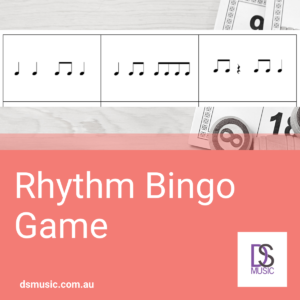Ways to gamify rhythm in your music classroom.
Comments Off on Ways to gamify rhythm in your music classroom.When exams are looming it can be tempting to take what’s needed for test-time and build your music classes around that. Here at DSMusic though, we’re fans of fostering music literacy and as keen on finding a variety of ways to scaffold really knowing these musicianship concepts in your spaces.
You can’t always address these areas through investigation, listening exercises, theory worksheets or sightreading repertoire, so here’s a few suggestions for gamifying rhythm in your classroom.

Rhythm Snake 1.
Sit/stand in a circle with your students. Then, clap a four-beat rhythm, which the class claps back while saying rhythm names. Get the student sitting/standing on your left to clap a new four-beat rhythm and have that be what the class claps back in rhythm names. You might scaffold this a little bit for them by having rhythmic ‘options’ visible on the board or on sheets in front of them. This means they’re receiving a visual reminder of each rhythmic grouping but also acts a little like compositional training wheels when their turn arrives.
Rhythm Snake 2.
This builds on the previous game, except the student on your left adds their own four-beat rhythm to yours (eight beats in total). Then, keep moving to the left, with the next student having a go. Essentially, each student claps eight beats in total — four they heard from the previous student and four they create on the spot. The best thing about this game is that they’re fostering an understanding of rhythm, and rhythm names but also furthering their memory muscles, aural awareness and creative chops.
DSMusic Top Tip: Make it sequential — step-by-step.

Rhythm Snake 3 (and the ‘Poison’ version).
Just keep building, just keep building. Take what you’ve established in the previous game and add another four beats. This will mean as we move around the circle, each student claps 12 beats in total while saying rhythm names. You can make this a little easier by reducing how many new beats are required (if four feels too hard, just add one!) but there’s also a way to up the stakes even further.
The poison version of this game is exactly the same except that of the available rhythms, one is removed from circulation. If students use this rhythm, they’re out and the circle snake begins again. For those classes of yours who love a challenge (or are particularly competitive or dopamine-driven!) you can extend this by assigning a particular beat that the poison rhythm cannot be clapped on.
Rhythm Bingo.
Who doesn’t love bingo? Or at least, bingo gives everyone an equal chance to win, which is always nice. It’s also another example of gamifying rhythm in your classroom and strengthening the understanding of these groupings in notated (and aural) form. Simply hand out sheets of bingo cards (see below) with rhythmic patterns on them. If you’re up for saving paper, best to laminate the bingo card sheets (class set!) and get them to mark each off with erasable markers or by placing a small token down.
Then, you (or a keen student) claps a rhythm from the master sheet that the students then clap back. If they’ve got the rhythm on their sheet they mark it off (and you should cross it off your master too!). The class claps the rhythm again, this time saying the rhythm names, while you (or that super keen student of yours) writes it up on the board. This provides a sure-fire way for the students (and you) to check there’s no dodgy bingo-ing happening. In order to win, a student must have any three groupings on their sheet across, down or diagonally, just like regular bingo.
Need to extend the game a little? No worries — just set the endgame as them having all the rhythms on their sheet.
How can DSMusic resources support you?
The great news is that we’ve pre-made your Rhythm Bingo sheet, so just access it by clicking the image on the right and get laminating!
If you’re seeking more ways to gamify this in your spaces, there’s a bunch of DSMusic FREE clever echo videos available:
And remember…
Whether you use these games as a brain-break activity, a way to warm-up your ensemble or as a dedicated chunk of time for this particular musicianship concept, don’t be afraid to get your students really knowing!
Happy gaming, everyone! – Deb



Comments are closed